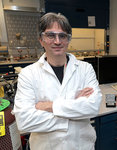

Peter Khalifah, a chemist working at Brookhaven National Laboratory and Stony Brook University, along with other contributors, developed a method to identify the atomic-level structure of materials previously too complex to decipher based on powder samples. Khalifah said that those participating in the procedure have developed a more comprehensive way for studying the ordered structure of matter and materials.
“In general, knowing the structure of a material is important to understanding how it works and why it works. If we want to make better materials, we can only do a good job of designing better materials if we have the appropriate structural insights.”
Previously, the structure of a sodium-ion battery cathode material, or NVPF, was largely unknown due to the complexity of the structure and the large amount of disorder present in the structure at room temperature, the typical environment of an operating battery. Due to the constant movement, the true structure and bonding environments are blurred. When exposed to cryogenic temperature, the movement of the sodium ions slows, and scientists are able to take a snapshot of the structure and extrapolate data to better understand the dynamic chemical bonds present at room temperature.
“We applied it to one specific sodium-ion battery system, but this method will also work for lithium-ion battery systems, which are very important with the growing number of electrical vehicles on the road and the plans for increases in the number of electrical vehicles. Electrical vehicles typically use lithium-ion batteries because of their high energy density.”
Khalifah went on to explain how it works.
When a three-dimensional atomic structure is flattened into a one-dimensional powder, much of the information regarding the material is lost in favor of simplicity. Complex materials composed of a multitude of elements, such as NVPF, lose a great deal of their novel characteristics; thus, it is impossible to fully understand a material based solely on its powder X-ray diffraction data.
However, computer algorithms can project all plausible structures based on the data gleaned from the much simpler powder sample. This way of solving for complex structures through a computational approach proves useful to identify the structure of novel functional materials.
Before this experiment, there were over half a million possible configurations for the sodium ions in NVPF. Computer algorithms shrunk these numbers dramatically; however, there remained many possible configurations.
“It is a simulation method,” Khalifah added. “Ideally, if I collect some structural data, like getting a powder diffraction pattern, I would want to look at the data in that powder diffraction pattern and know what the structure is.”
Computer algorithms can project all plausible structures based on the data gleaned from the much simpler powder sample. Khalifah described powder diffraction patterns as a set of peaks on a graph.
“If you have a crystal structure, it is very easy to ask and predict what the diffraction pattern should look like. Instead of going from the diffraction pattern to the structure, we are reversing the process, generating lots of structures, generating the diffraction patterns,” Khalifah said.
Computer algorithms shrunk these numbers dramatically. However, many possible configurations remained. Only software could be used to differentiate between the predicted diffraction patterns and experimental patterns due to the relatively small differences between the two data sets. Typically, this degree of difference would be negligible to the human eye. Multiple trials were conducted to ensure a high degree in confidence of the finial structure.
Only by using a software to predict the powder X-ray diffraction pattern for each possible structure and then comparing the calculated results to the actual measured diffraction pattern could the actual three-dimensional structure be determined.
Comments
No comments on this item Please log in to comment by clicking here